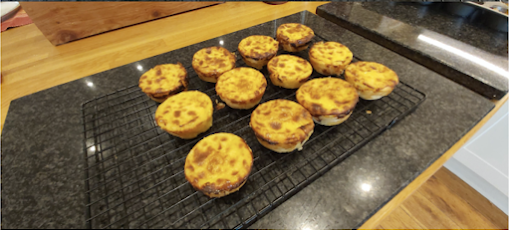Pastel de Nata - Portuguese Custard Tarts
Pastel de nata is what Lisbon is all about.
The small custard tarts were invented in the nearby Mosteiro dos Jerónimos (Hieronymites Monastery) in the 17th century by the brothers of the Catholic order of St. Jerome.
At that time, egg whites were commonly used to starch religious habits and using egg yolks for cakes became commonplace.
When the monasteries were closed down after the Liberal Revolution of 1820, the religious brothers started selling pastel de nata on the street of Lisbon. Fourteen years later, in 1834, street selling ceased and production opened up again in 1837 at the Fábrica de Pastéis de Belém.
In 2009, the Guardian voted pastel de nata as one of the 50 'best things to eat in the World'.
The Belém factory now sells in excess of 22,000 tarts every day.
They say you can't have a proper Greek salad outside of Greece nor a proper Italian pizza outside of Naples. That may be true. I thought you couldn't buy a proper pastel de nata outside of Lisbon intil I went into Cafe Marina, a Portuguese cafe on Lordship Lane in Tottenham. And that got me thinking....
After months and months of searching, I found a recipe that works. It will produce authentic-tasting pastel de nata that will whisk you back to sun-drenched days sitting outside the blue and while tiled Confeitaria Nacional Belém on Avenida Brasilia; lingering over a café and a small custard tart, the very essence of Lisbon.
INGREDIENTS FOR AT LEAST TWELVE TARTS.....AND POSSIBLY A FEW MORE...
45 gms plain flour
quarter teaspoon salt
375 mls of milk
67 gms caster sugar
79 mls water
6 large egg yolks
1 teaspoon vanilla extract
1 cinnamon stick
The peel of one lemon - cut into strips
1 sheet of pre-rolled puff pastry
Preheat your oven to 290 degrees C
Lightly grease a 12-cup muffin tray or a mince pie tray.
TO MAKE THE CUSTARD
1. In a saucepan, bring to the boil the sugar, water, vanilla extract, lemon peel and cinnamon stick.
Take it off the heat when it reaches 100 degrees C. Don't stir it.
2. Separately, thoroughly whisk together the milk, flour and salt.
Cook over a medium heat, whisking continually until everything is combined (about 5 minutes) and the milk thickens. Take it off the heat and allow it to cool for about 15 minutes.
Remove the cinnamon stick from the syrup and add the syrup to the egg and milk mixture. Mix everything together until it's well combined.
Sieve the mixture into a jug.
TO MAKE THE PASTRY CUPS
4. Cut the puff pastry sheet into two and place on top of each other. Tightly roll the pieces into a log - start from the short side.
Cut the log into 12 even-sized pieces.
5. Place one piece in each of the 12 wells of the lightly-greased muffin tin. Dip your fingers into cold water and press your thumb in the middle of the dough piece working the dough outwards to form a pastry cup. Press and mould until the top edge is just above the top of each well of the muffin tin.









Looks delicious! I was particularly interested in the references to Dorothy Hartley - or Miss Hartley, as we all referred to her in Froncysyllte. I remember her as a polite, dignified figure, walking around the village, wearing flowing dresses, and carrying a basket on her arm. She was one of the many seemingly eccentric characters woven into the rich tapestry of life in this little Welsh village. Dylan Thomas would have loved them all! She always seemed a little “apart”, and reading her background, you can see why. A few years ago, Lucy Worsley visited Fron House for one of her documentaries, and interviewed one of our relatives who knew Miss Hartley well. Miss H would have been pleased that, for a short time, a couple of years ago, Fron House became a lovely tea room, selling delicious cakes! Thanks for this from Lynwen of Fron.
ReplyDelete